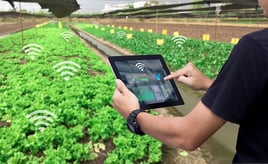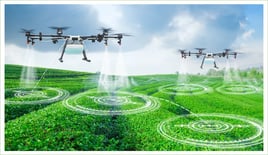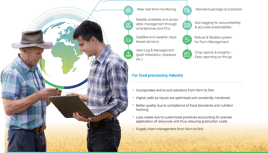Digital FarmingUsing technology for data-driven decision making
An overview of digitalization
Whenever you are booking an Uber or making payments directly through apps on the phone, you are using a digital platform for performing tasks that were once manual. The incorporation of technology in everyday tasks to improve functionality is known as Digitalization.
Going back a few years, remember the time when opening a bank account required a visit to the bank and waiting in long queues?
Thanks to the recent rapid digitalization, the exhaustive paperwork in banks, hospitals, and most private and public sector organizations seems to diminish as their businesses move online. Digitization has reduced the manual work - which was time-consuming, error-prone, and inefficient thus saving corporations millions.
With advancements in AI, the data analysis capabilities have improved so that all the appliances in our house can be managed by a virtual assistant that can understand human voice commands and respond. Proving to be a boon to every sector, digitalization in agriculture is also slowly revolutionizing this vast and complex sector that remains the center of the world economy as still over 60% of the global population depends on it for survival.
Introduction to digital farming
Digital farming can be defined as the use of technology by farmers to integrate financial and field-level records for complete farm activity management.
According to a paper by the Direct Line Group,
“Digital Farming is the consistent application of the methods of precision agriculture and smart farming, internal and external networking of the farm and use of web-based data platforms together with Big Data”
Data from each plot can be analyzed to provide information on soil, weather, and crop growth patterns to give actionable geographically relevant timely insights to prevent losses and optimize the productivity of each plot on the farm.
Farmers can even get their queries solved and manage the supply chain directly through applications on their phones. Through pre-harvest and post-harvest management of farms, digital farming aims to take over all the aspects of farming from farm to fork.

Digitalization of farm data for actionable insights
Digital farming gives farmers access to timely valuable insights so that they can adopt best practices and manage farms more efficiently thus reducing losses and maximizing profits. Technologies offer a variety of solutions for adapting to advanced farming. IoT in agriculture consists of sensors, drones, and computer imaging integrated with analytical tools for generating actionable insights. Placement of physical equipment on the farms, monitors and records data which is used to get insights. Due to advancements in satellite imagery, machine learning, and data storage in clouds, predictive analytics software has been pretty favorable as they are highly scalable and easy to use.
Technologies used in Digital Farming
Digital Farming is the integration of precision farming and smart farming and is achieved through the implementation of intelligent software and hardware.
Precision farming is popularly defined as a technology-enabled approach to farming management that observes, measures, and analyzes the needs of individual fields and crops. Smart farming is more focused on the use of data acquired through various sources (historical, geographical, and instrumental) in the management of the activities of the farm.
Digital Farming can be done through the installation of network-connected ‘smart’ devices as part of IoT (Internet of Things) or they can be software as a service (SaaS) based agtech.
When hardware transfers data over a network they become ‘smart devices’ and become part of the Internet of Things (IoT). IoT in agriculture comprises the use of sensors, drones, robots, and cameras. Sensors, cameras, and robots are installed on the farms and record the data.
Drones in agriculture can be used as pay per services or can be bought and stationed on farms. The IoT equipment needs to be connected to an analytical dashboard for the analysis of data. IoTs are used for field-related data only. They can’t help manage the overall farm activities and show the data in terms of financial gains or losses. They are just data.

Since IoT utilizes hardware, it requires solid technical knowledge for operating the equipment along with high maintenance and setup cost. The high capital input cost is what keeps IoT out of the reach of most farmers.
Software as a service (SaaS) is the more economical and scalable way to upgrade to digital farming. Leading Agri tech companies like Cropin utilize machine learning and satellite monitoring for performing predictive analysis and delivering customized reports and actionable insights directly to farmers’ screens. The intelligent agriculture cloud platform is gaining popularity pretty quickly among businesses as they can assess and manage their overall farm operations with one software and this is a low-risk investment with monthly and yearly subscriptions. Companies like Cropin are becoming one-stop solutions for driving Farm Management, Traceability, Sales Management, and Risk Management in the Agri sector.
Benefits of Digital Farming
Benefits of a digital agriculture solution for a food processing industry
- Incorporates end-to-end solutions from farm-to-fork
- Higher yields as inputs are optimized and constantly monitored
- Better quality due to compliance with food standards and nutrition tracking
- Less waste due to customized practices accounting for the precise application of resources and thus reducing production costs
- Supply chain management from farm to fork.

Below are some of the benefits of Cropin's digital farming solution
- Near real-time monitoring
- Standard package of practices
- Readily available and accessible management through smartphones and PCs
- Geotagging for accountability and accurate predictability
- Satellite and weather input-based advisory
- Robust and flexible system for farm management
- Alert log and management (pest infestation, diseases, etc.)
- Crop reports and insights- easy reporting on the go.
Challenges of Digital Farming
High cost of adoption
Many digital farming technologies can be expensive, which may be a barrier.
Limited access to technology
In some cases, access to digital farming technologies may be limited, particularly in developing countries or rural areas with limited infrastructure.
Training and knowledge
There may also be a learning curve associated with using digital farming technologies, and farmers may need to be trained in order to use them effectively.
The Digital Farming Solution
Cost of a Digital Farming Solution
The cost of in-house development is almost 10 times or more than the cost of implementation of a SaaS Product. Further additional software infrastructure in terms of Servers, Maintenance, and Software Licenses (Microsoft, SQL, Google License, etc.) is a huge cost that the organization has to bear independently. At Cropin, the license and the cost are spread across hundreds of clients which makes it viable for all.
Data Security & Warehousing
Organizations would require to have teams and products for data security and warehousing so that the information can be effectively used across the years for analysis and decision-making. Many organizations having their inhouse product have missed this part thus data utilization has become a big challenge.
Money Value of Time
The product development to implementation cycle for a product like basic crop management software can be between 12 to 24 months and the business would lose valuable time during the entire process. Farm management companies such as Cropin have a dedicated team to develop and maintain this product.
Changing Industry & Business Needs
The industry is dynamic and the need for products, reports, and ways of farmer engagement is changing very fast. By the time one product would have been developed the needs would have changed. Management companies take into consideration all such changing environments and provide the best solution suitable for that time. For example, Cropin was just mobile-based in an earlier version, now it is an intelligent agriculture cloud-based solution. Periodic upgrading is a part of our continuous product improvement.
Valuable Experience
Out-house management companies have a dedicated team for Project Implementation, Customer Success, and Data Science that have extensive experience and knowledge in successfully implementing products and solving the common challenges faced in the field. Cropin has developed intelligent Agri tech over the last 10 years through multiple iterations to make it user-friendly, consistent and robust which gives the users a great experience to easily use and benefit from it. Such a level of service will not be possible when developing an in-house digital farming solution.
Applications of Cropin's Digital Farming Solution
Digital Farming for Multinational Seed Companies
Cropin's digital farming solution helps multinational Seed Companies strategize to drive a digital growth strategy within the organization.
Leveraging digital agriculture to help the seed value chain
Seed companies can utilize digitalization in each and every layer of operation from seed research and development to seed selling. All of the activities from labs to farmers can be managed on a single screen using Agri-SaaS products of Cropin. Below is an understanding of how each division in a seed company can benefit from using digital solutions:
Digital Farming Solution for Seed Research and Development
Seed Research and Development is a game of field trials and careful observation and selection. Digitization of the trial data from the field stations will help the heads of R&D to get a complete performance overview of any seed variety.
Digital Farming Solution for Seed Production
This process involves the selection of the best seeds from the R&D phase and plotting them in larger areas for creating similar seeds.
Digitalization in the seed production phase-
Cropin Grow (SmartFarm) can be used by field agents to record the data on the field in an MIS for management to monitor activities from the head office. SmartRisk can be used in Crop growth detection, Crop health detection, and Crop stress detection. SmartPulse is designed specifically to be used by the management to monitor the location of your field agents.
Digital Farming Solution for Seed Processing and Tracking
After harvesting, the management of seeds can be done digitally through SmartWare. One of the biggest issues today faced by farmers is fake seeds. Traceability can solve this problem as it tracks the source of seeds. Traceability can also be used for tracking and removing seeds from the market that don’t meet the certification standards. QR codes on the packet can be scanned to view the complete history of the packet of seeds and hence farmers know that the seeds are genuine.
Digital Farming Solution for Seed Distribution and Sales
Seed Companies can manage their entire seed distribution and sales through Cropin. SmartSales can be used to manage the Market development team and Sales officers.
The market development team visits farmers and demonstrates the quality of seeds by sowing half of their seeds and half of the current farmers. The comparative study is used to depict which seed is better. This process can be digitized by using SmartFarm where the farmers’ data can be captured and managed by MIS. Sales officers can use SmartRisk to detect the rains and hence target selling seeds to areas where it has freshly rained or is about to rain. Thereby timely providing seeds to retailers there. They can also use SmartRisk to identify what is grown through the area and target selling those seeds in the area. Companies can also utilize AreaSquare- a social media for farmers, to broadcast advice on how to sow their seeds for the best outputs.
Digital Farming- Adding value to Agri-lending and Agri-insurance processes
Cloud-based Agri tech SaaS solutions find a breakthrough application in agri-lending and agri-insurance by providing actionable insights on the associated risk of the farm plot. MIS keeps cloud storage for the storage of history that is available about the farms. Suppose a farmer comes in and asks for a loan, the bank can use agritech SaaS such as Cropin to look into the farmer’s records relative to the yield and profits in the last ten years.
Based on the historical cropping patterns, Cropin’s SmartRisk can estimate yield. This helps banks and insurance in several ways. Firstly, It helps the farmers by increasing their credibility. If the records and predictions show that farmers have been performing well and yield will be good, the loan or insurance amount will be higher. Currently, the same insurance amount is given to all farmers irrespective of their individual performance.
Secondly, the banks and insurance companies will be benefited from digital farming as the data obtained is highly accurate, hence can help stop bad lending.
The Digital Farming Solution- Questions we get asked
Why can't I host a Digital Farming Solution such as Cropin's on my own premise and on my own server?
Cropin is the first agriculture cloud platform and has a complex three-level data insights structure, with licenses and integrations to function at its optimum capability.
Multiple Licenses
These licenses include a Google license (Business Applications, Analytics, etc.), SQL server License, etc. This would require a large cost to keep the platform running if it is hosted out of your infrastructure.
Higher Cost
Secondly, the cost of upgrades and providing clients with the required features and reports would be much higher as our technical team would have to access your infrastructure to do the changes. This would add the additional cost of support which will be high.
Data Security and Maintenance
Third, the cost of data security and maintenance, data warehousing for analytics, etc would involve much higher costs in the long run.
I am currently using WhatsApp to manage my business. Why do I need a Digital Farming Solution?
WhatsApp is an SMS replacement system providing information that is not copied, kept, or archived and data is only residing on the mobile device of the sender and receiver and can be deleted at the user's discretion with no record. Very less business value can be generated from it.
For an organization, data is key for decision making and it is important to capture, record, and analyze information in the form of Data.
Also, things to consider while transitioning to digital farming are:
- Whatsapp does not store anything on its server. Hence, no digitization of your records and data
- Data does not get converted into actionable intelligence
- It does not send you an alert when Key Result Area (KRA) is not met
- Cannot work without the internet unlike our mobile application
- There are no reports of BI or Intelligence that can be done through Whatsapp data
Cropin has combined 12+ years of expertise in the global Agri industry to build Cropin Cloud - a multi-tenant, secure, scalable, flexible, and intelligent agriculture cloud platform.
With this first-of-its-kind industry platform, we aim to provide a complete set of agriculture-specific capabilities with the specific intention of helping accelerate business growth and bring about a rapid and far-reaching digital transformation across the agri-ecosystem.
The Future of Digital Farming
The United Nations projects that by the year 2050 the population of the world will be 9.7 Billion. With the relevance of over 60 percent of the world population on agriculture for food, the pressure to increase production to meet demands doesn’t seem to ease. Coupled with climate change, which is leading to rising global temperatures, levels of carbon dioxide, and frequency of droughts and floods, along with increasing labor costs, high production costs, and unpredictability poses a major challenge to the future of agriculture. Hence, the goal is to adopt climate-smart agriculture and increase productivity sustainably. To increase sustainability a very precise and calculated set of practices designed specifically for a plot needs to be followed and to follow best practices data needs to be recorded and analyzed digitally.
Frequently Asked Questions
Digital farming, also known as digital agriculture, refers to the use of digital technologies to improve the efficiency and productivity of agriculture. This can include technologies such as remote sensors, drones, precision irrigation systems, and GPS-guided machinery, as well as the use of data analytics, AI, and machine learning to make informed decisions about crop management and farm resource allocation.
Digital farming involves the use of varied technologies, including sensors, drones, precision irrigation systems, GPS-guided machinery, and data analytics and machine learning tools. These digital farming technologies can be used to collect data about soil conditions, crop health, weather patterns, and other factors that impact agriculture.
Digital farming can provide various benefits, such as increased agricultural efficiency, reduced costs, improved crop yields, and reduced environmental impact. It also helps farmers make more informed decisions about crop management and resource allocation, and can help improve food security by maximizing production and minimizing waste.
Challenges include the high cost of equipment, implementation, and management of digital farming technologies, limited access to data and connectivity in rural areas, and potential data privacy and security issues. Additionally, there is a learning curve involved in implementing new technologies, as it may take time for farmers to adopt digital farming solutions.
It is expected that digital farming will play a key role in addressing global food security challenges and in helping farmers adopt climate-smart agriculture practices.





